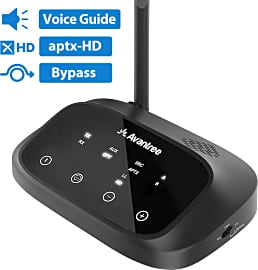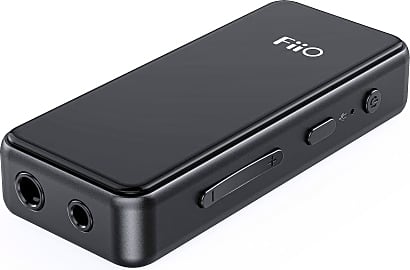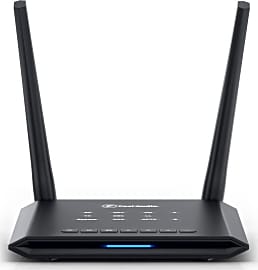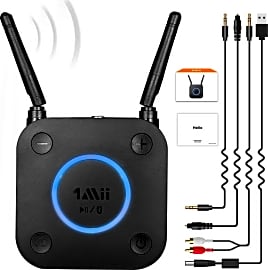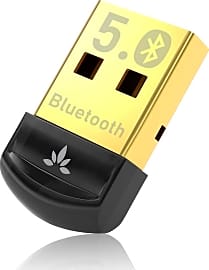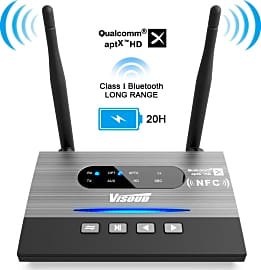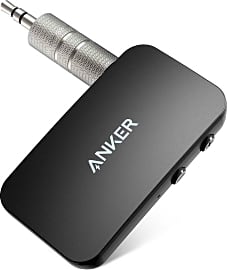The 10 Best Bluetooth Receivers

This wiki has been updated 38 times since it was first published in June of 2015. Just because your electronics don't have Bluetooth built in doesn't mean they're destined for use with only wired inputs. The right receiver can turn most devices wireless, including active speakers, car stereos, home theaters, and even your favorite pair of wired headphones. Following are some of the best upgrades you can make in a variety of form factors and price ranges. When users buy our independently chosen editorial recommendations, we may earn commissions to help fund the Wiki.
Editor's Notes
November 24, 2020:
Broadly speaking, Bluetooth receivers fall into one of two categories. Portable options like the EarStudio ES100 MK2 and FiiO BTR3K are great choices for turning wired headphones wireless, and the Anker Soundsync A3352 is good for adding Bluetooth streaming to vehicles with only an auxiliary input.
In terms of stationary units, the 1Mii B06 Pro, Avantree Oasis Plus, and Fosi Audio BT05 are generally used as Bluetooth sinks for sending audio from a TV to a pair of active speakers. The key with these is to make sure that every link in the chain supports the aptX Low Latency codec, which keeps the lip sync delay to a minimum.
There are also some that can take a Bluetooth signal and process it to sound as good as possible, which isn't terribly important for TV, but is much more relevant if you're setting up a mid-range home stereo. Models like the Audioengine B1 Premium and BluDento BLT-HD make it easy to stream music from smartphones, laptops, and tablets without sacrificing quality.
We also want to highlight the Avantree DG45, which is specifically not very good for streaming audio, because it only supports the mediocre SBC codec and doesn't offer low-latency performance, but it's possibly the most dependable Bluetooth 5.0 dongle on the market right now.
November 08, 2019:
There are two common types of Bluetooth receivers. One is geared toward home entertainment; this type is perfect for routing into any self-powered speaker to create a straightforward in-home streaming setup. The Visoud Long Range is one of the most versatile of these, with selectable transmit and receive modes as well as an optional bypass setting. It also has separate connectors for both the inputs and outputs so you shouldn't ever have to switch any plugs around. The Avantree Oasis Plus is just about as flexible, though it only has one set of output connectors. The Audioengine B1 Premium and BlueDento BLT-HD are worthy of consideration if you're especially concerned with high-fidelity sound. Meanwhile, the 1Mii B06 Plus is a decent and very inexpensive in-home unit, and the Anker Soundsync A3352 is suitable for anyone who wants an easy way to listen to Spotify in their car.
On the other hand, if you want to turn a good set of wired headphones into a wireless pair, there are a handful of highly convenient DACs with baked-in Bluetooth support. The EarStudio ES100 and FiiO BTR3 are both of comparably high quality, with support for some of the high-end codecs that make the most difference when it comes to wireless audio transmission. The Fiio BTR1K offers much of the same audio fidelity overall, however it doesn't have all the same high-end codecs as the other two.
How Bluetooth Technology Works
The technology is designed with a master-slave structure and each master has the ability to control up to seven slaves, or devices.
If you're not familiar with Bluetooth technology, well then you've probably been living under a rock for the last decade. Just in case there are a few of you who have been using it without knowing what it's called, you know that nifty little setting on your phone that lets you wirelessly stream music and other data to a pair of speakers or a TV? That's Bluetooth and it's probably one of the coolest things to happen to the mainstream consumer society since well, the smartphone itself.
It allows us to exchange data over short distances and to build small personal area networks by utilizing short wavelength UHF radio waves from 2.4 to 2,485 GHz. It can be broadcast from fixed or mobile devices and allows you to connect with other devices, even if you don't currently have access to a wireless internet source.
Bluetooth is a packet-based protocol, which means it divides data into suitably sized blocks for faster transmission. This makes it extremely efficient and able to transmit a large amount of data nearly instantaneously. Each packet is transferred via one of 79 channels that have been designated for Bluetooth. Each of the standard Bluetooth channels has a 1 MHz bandwidth, while the new Bluetooth low energy technology uses 2 MHz spacing over 40 channels. When it makes a connection, it continuously hops between the different channels to ensure it has the most stable and the fastest connection possible.
The technology is designed with a master-slave structure and each master has the ability to control up to seven slaves, or devices. All of the connected slaves share the master's clock and the packet exchange timing is based on this shared clock, which ticks at 312.5 µs intervals. It takes two ticks to make up what is known as a slot and all data is sent or received in a slot. The data transfer is timed so that the master sends out information on even slots and receives in odd slots. The slave does the opposite and sends out information on odd slots and receives on even slots to prevent any jumbled communications.
History Of Bluetooth Technology
Bluetooth made its first appearance in the 1940's when World War II was in full swing. The initial development was mostly undertaken by Hedy Lamaar and George Antheil, and it was intended to be a radio guidance system for Allied torpedoes. Because of its unique frequency hopping technology, it was able to workaround the Axis's jamming systems. Unfortunately it was never really implemented and dropped by the wayside until the Navy began to use it in the 1960's. While this wasn't exactly the type of Bluetooth we are using in our phones today, it was the beginnings.
As it turns out, Bluetooth did in fact have a future as today it reaches impressive speeds upwards of 20Mbps.
Decades later in 1989, work on the technology began again in earnest. It was initiated by the CTO of Swedish communications and technology company Ericcson and Dr. Johan Ullman. By 1994, the company had it working, but not quite up to its full potential. They realized that to produce the best technology possible, they would need development help from other major players in the industry, many of which were already working on a similar technology of their own. They invited Nokia, Toshiba, and Intel to set up a joint development project. Intel took them up on their invitation and by 1998 the technology was ready for launch.
Initially they touted the technology as being able to transfer up to 721 kpbs, which didn't have the intended wow factor as many people in the industry rebuffed them, saying that WiFi could offer a lot more. As it turns out, Bluetooth did in fact have a future as today it reaches impressive speeds upwards of 20Mbps.
Originally the technology was called MC Link, but later renamed as Bluetooth in an homage to the tenth-century Scandinavian king, Harald "Blåtand" Gormsson, also known as Harald Bluetooth. He united the dissonant Danish tribes into a single kingdom and, since Bluetooth unites communication protocols into a single universal standard and was created by a Scandinavian company, it seemed a fitting term. The well-known Bluetooth logo is actually the merging of two Younger Futhark runes with Harald's initials.
Picking The Right Bluetooth Receiver
When it comes time to pick the right Bluetooth receiver for your needs, one of the most important factors to take into consideration is the transmission range between your receiver and your transmitting device. Some receivers have a considerably wider range than others, so some may be more suitable for commercial use or in larger homes where you have more distance to cover. Others might work perfectly for your needs in a smaller home and might also be a better fit for your budget.
The next thing to keep in mind is compatibility with your devices. While this usually isn't a problem nowadays as most Bluetooth technologies are backwards compatible, meaning they work with older versions of Bluetooth, it should still be double checked. There is nothing worse than buying a Bluetooth receiver and finding out it won't work with your transmitting device.
If you intend to have multiple devices connected to a Bluetooth receiver at the same time, you should consider how many devices can be linked to your receiver before it drops a connection. Some may only allow connection to one device at a time, while others may allow for two or even three simultaneous connections.


